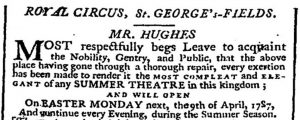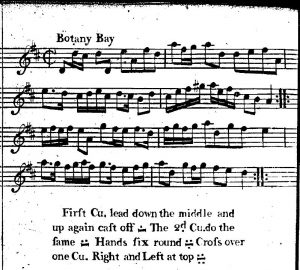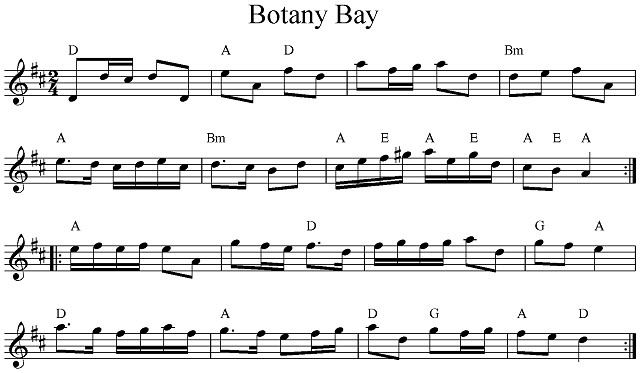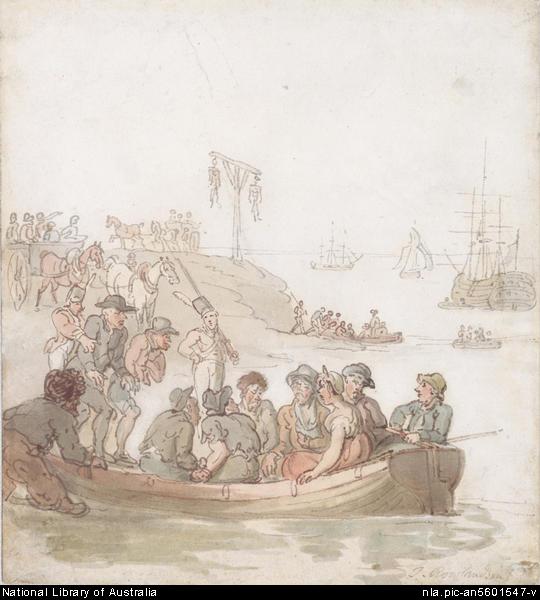As the First Fleet prepared to sail to the other side of the world to found a ‘thief’ colony in New Holland, a remarkable show was being staged at the Royal Circus, London.
The favourite opera,
Botany Bay

Advertisement for the favourite opera of Botany Bay.
World and Fashionable Advertiser (London, England),
Wednesday, May 9, 1787; Issue 111.
This theatrical creation provided a imaginative portrayal of the approaching voyage and settlement of approximately 700 convicts who were awaiting transportation. Little is known about the opera apart from the newspapers advertisements and several brief reviews:
The Botany Bay petite piece was interesting, and the characters well supported… 10 April 1787. [1]
The opera of Botany Bay is partly moral and party comic, on the whole a good thing… 14 April 1787. [2]
The little opera, Botany Bay, may be alright for the holiday people [during Witsun week], its passable for the Circus but not plot enough for the Royal Theatre. June 1, 1787. [3]
At the time the theatre was an important way for the public to learn about current affairs. Apart from newspapers and broadsides, there were few ways to hear about the news, consequently the “theatre incorporated the news report, the documentary, the annual review of the year’s events, the travelogue, popular science and popular history…”[4]. Portrayals of events on the stage gave audiences a way to visual the people, locations, and activities taking place.
There were only two licensed theatres in London, and while these presented serious plays, a variety of other venues provided more light-hearted performances featuring music, song, and dance. The Royal Circus was such a venue. Opened in 1782 by the actor and composer, Charles Dibden, and Charles Hughes, a well-known equestrian performer, it had been renovated “to render it the most complete and elegant of any summer theatre in this kingdom”[5] for the season of 1787.

The Royal Circus underwent “a thorough repair” in readiness for the 1787 summer season, “rendering it the MOST COMPLEAT and ELEGANT of any SUMMER THEATRE in the kingdom.” [5]

The list of dancers who performed at the Royal Circus on the opening night of Botany Bay.
Dancing was a key element in the theatre and many plays included dances which were later published, allowing everyone the opportunity to enjoy the latest fashions. [5]

Botany Bay from Twenty Four Country Dances for the Year 1788, Thomas Skillern, London.
Courtesy of Kate Van Winkle Keller
The tune and dance are historically significant as the first compositions directly related to the English settlement in Australia. This fascinating story can now be brought to life with music and dance.
Recording from our CD – Captain Cook’s Country Dance: 19 dances from the early colony
 Twenty Four Country Dances for the Year 1788. T. Skillern, London.
Twenty Four Country Dances for the Year 1788. T. Skillern, London.
Arr. Roland Clarke Download the pdf
Country dance: longways duple minor
| A1 | 1-8 | 1st couple lead down the middle, |
| 5-6 | 1st couple lead back to the top, | |
| 7-8 | 1st couple cast into second place WHILE 2nd couple move up. |
|
| A2 | 1-4 | 2nd couple lead down the middle, |
| 5-6 | 2nd couple lead back to the top, | |
| 7-8 | 2nd couple cast into second place WHILE 1st couple move up. |
|
| B1 | 1-4 | Circle left, |
| 5-8 | Circle right. | |
| B2 | 1 | 1st couple cross by the right shoulder, |
| 2-4 | 1st couple cast off one place and cross by the left shoulder, end facing up, WHILE 2nd couple move up to first place, end facing down. |
|
| B2 | 5-8 | Four changes of a circular hey. Start by passing right shoulders on the side with neighbour. |
In August 1786, the Secretary of the Home Office, Lord Sydney, announced that on instruction from His Majesty, it had been decided that Botany Bay was a most suitable place to receive transported convicts. Prisons were overcrowded and a solution was urgently required. The loss of the American colonies in the War of Independence meant Britain could no longer dispense with surplus criminals as had been the case for much of the eighteenth century, and a new “dumping ground” was anxiously sought.
The plan to send convicts to Botany Bay was based on the evidence of Sir Joseph Banks, the botanist who accompanied Lieutenant Cook there in 1770. Banks was immensely influential and suggested the site as ideal for a “thief colony” – so distant as to remove the possibility of escape yet sufficiently fertile to become self supporting within a year.
Little was known about the destination, even the London Press was vague, informing readers it was situated on the west side of the island of New Holland in the Indian Ocean. Despite criticism of the plan being absurd and impractical, the First Fleet arrived in Botany Bay in January, 1788.

Convicts embarking for Botany Bay. Thomas Rowlandson (1800).
Courtesy National Library of Australia.[7]
“It is difficult to believe that they “came to town” in mid-summer for unimportant business, and it was shortly after this that Lord Sydney took the action which launched the colony. On May 13 1787 the First Fleet slipped anchor in Spithead, bound for Botany Bay and the other side of the world.” [8]
The whimsical idea of founding a settlement of convicts on the other side of the world prompted many humorous street ballads, an opera and this dance.
___________________________________________________________________________________________________________________________
[1] World and Fashionable Advertiser (London, England), Tuesday, April 10, 1787; Issue 86. [2] Gazetteer and New Daily Advertiser (London, England), Saturday, April 14, 1787; Issue 18204 [3] World and Fashionable Advertiser (London, England), Friday, June 1, 1787; Issue 131. [4] Fotheringham, R., & Turner, A. (2006). Australian plays for the colonial stage : 1834-1899 (Academy ed.). St. Lucia, Qld: University of Queensland Press. [5] Advertisements and Notices. (1787, April 9). World. Retrieved from https://link.gale.com/apps/doc/Z2001548867/GDCS?u=bccl&sid=GDCS&xid=a292cd1b [6] Keller, R. M. (2006). Dance Figures Index: English Country Dances, 1650-1833. from The Colonial Music Institute https://www.cdss.org/elibrary/DFIE/Index.htm [7] National Library of Australia. Picture: Convicts embarking for Botany Bay. T. Rowlandson. Rex Nan Kivell Collection NK228. http://trove.nla.gov.au/version/15929351 [8] Australia’s Heritage. The Making of a Nation. Volume I. Lansdown Press Sydney 1988.Sources
Gale Historical Newspapers https://www.gale.com/intl/primary-sources/historical-newspapers
World and Fashionable Advertiser (London, England), Issues 84-99, 107, 102, 103, 108, 111, 113, 131, 182
Public Advertiser (London, England), Monday, April 1787; Issues 16512, 16513, 16513. Times (London, England) April 24, 1787.
World and Fashionable Advertiser (London, England), Tuesday, April 10, 1787; Issue 86.
Gazetteer and New Daily Advertiser (London, England), Saturday, April 14, 1787; Issue 18204.
World and Fashionable Advertiser (London, England), Friday, June 1, 1787; Issue 131.
World and Fashionable Advertiser (London, England), Thursday, August 2, 1787; Issue 182.
World and Fashionable Advertiser (London, England), Wednesday, August 15, 1787; Issue 193.
Select Bibliography
Frost, A. (2012). Botany Bay: the real story (Vol. 2nd). Collingwood, Vic: Black.Keller,
Hanna, C. (1985). ‘A bit of cackle’: Australia’s beginnings in English drama. Australasian Drama Studies, 3 (2). http://search.proquest.com/docview/1300396580/
King, Jonathan. The First Settlement. The convict village that founded Australia 1788-1790. The Macmillan Company of Australia Pty Ltd, Sydney 1984.
Phillip, Arthur. The Voyage of Governor Phillip to Botany Bay. Hutchinson of Australia, Vic. Facsimile edition 1982.
MacDougal, A.K. An Anthology of Classic Australian Folklore. Five Mile Press, Victoria, 1994.
______________________________________________________________
This resource was created on the lands of the Gubbi Gubbi people.
We pay our respects to their elders past and present.
Sovereignty was never ceded.
______________________________________________________________
Header credits:
1. Portrait of Captain Cook by Nathaniel Dance-Holland [Public domain]
2. A jig on board by Cruikshank. Courtesy of The Lewis Walpole Library, Yale University
3. View of the South Seas by John Cleveley the Younger [Public domain]
______________________________________________________________
The information on this website www.historicaldance.au may be copied for personal use only, and must be acknowledged as from this website. It may not be reproduced for publication without prior permission from Dr Heather Blasdale Clarke.
______________________________________________________________



Pingback: Special Events | Australian Colonial Dance